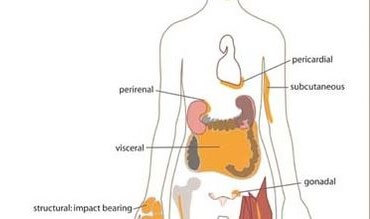3 Types of Belly Fat – Visceral, Subcutaneous and Intramuscular

Part 3 – Visceral Fat | Rid the Belly Pouch and Muffin Top
3 Types of Belly Fat – Visceral, Subcutaneous and Intramuscular. So I previously covered Intramuscular Fat and Subcutaneous Fat, and today I am wrapping it up with VISCERAL FAT.
VISCERAL FAT is the most dangerous kind of fat to have. It lies deeper inside the abdomen and surrounds the abdominal organs (this is what gives guys that “beer belly” appearance where their abdomen protrudes, and at the same time feels hard if you push on it). People gain this belly fat for many different reasons: eating lots of high fat or high sugar foods, maintaining an inactive lifestyle, not exercising for long periods of time, not getting enough sleep, and being stressed.
HORMONES AND AGING PLAYING A ROLE
Hormones play a large role, particularly in menopausal women. Aging is also a major factor in getting this type of fat: people tend to lose muscle mass as they age, which leaves them with a higher percentage of body fat in general. This then changes the way the body burns calories, which then makes it easier to gain abdominal fat.
Gaining this type of fat greatly increases your risk of developing heart disease, diabetes, high blood pressure, strokes, sleep apnea, various forms of cancers, and other degenerative diseases. Not to mention it is extremely hard on your lower back.
CHECK YOUR WAIST MEASUREMENTS
So check your waist: women with a waist over 34 inches (87 centimeters) and men over 39 inches (99 centimeters) are at a much greater risk for excess visceral fat health problems.
And now that we know what visceral fat is, where it is in your body, and the dangers of having it, the big question is: How do we get rid of it? Well unfortunately there’s no magic pill – it’s all about combining a nutritious diet and an exercise program that stimulates the metabolic response within your body.
So get ready, put your big girl pants on, and lets get busy.
DIET
Changing your diet is important when trying to reduce and prevent the buildup of visceral belly fat. In order to lose belly fat, you must eat fewer calories than you burn through daily exercise. So:

- Aim to reduce your calorie intake by 500 calories per day
- Eat healthy and unprocessed foods.
- Increase nutritious high fiber foods like vegetables, 100% whole grains and fruits, eat more omega 3 fish, low-fat dairy, and lean poultry.
- Use monounsaturated fats like olive oil, and eat walnuts and avocados which have monounsaturated fats. These will help your body metabolize the belly fat.
- Drink reduced-fat milk like 1% or skim: the calcium increases the activity of enzymes that break down fat cells and reduces the stress hormone cortisol, which triggers your body to hoard belly fat.
- Do not eat high glycemic foods like refined grains and sugar, avoid fatty fried or sodium filled foods, and keep your saturated fat intake low. Toss the trans fat (which have been shown to pack on body fat in the abdomen), which are found in prepackaged treats.
- Limit or eliminate alcoholic beverages

EXERCISE
The solution to getting rid of the visceral fat is two fold: you need to combine a weight bearing targeted exercise, along with dynamic movement. The weight bearing exercise will strengthen your abs and obliques, and make your core strong; and the dynamic movement to reduce your body fat, so you can actually see your abs and obliques, is all about aerobics and cardio. Studies show that a high-intensity aerobic exercise is the most effective at burning off visceral fat, so aim for a good 30 minutes, 4 times a week of either walking, bicycling, jogging, or swimming, just to name a few.
So yup, there’s no other way around it. But remember all this will be worth it. Just stick with the weight loss regime of eating a healthy, low calorie diet and increase your physical activity. Studies show that your belly fat will be the first to go.
Good luck and cheers to your good health 🙂
Great post! Anyone looking to slim down should definitely look into okinawa. Its a japanese health drink that burns fat better than any diet that ive ever tried, and ive tried many! Heres a great review of it:
https://okinawaweightloss.weebly.com/
Keep up the great content!
thank you. Will have to look into the okinawa drink
thank you
I absolutely agree – the okinawa program is remarkable. Love the other review of it too. Thank you